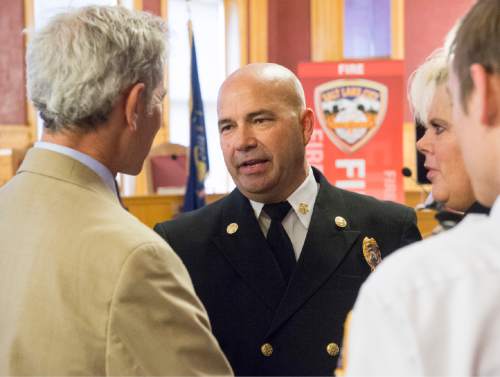This is an archived article that was published on sltrib.com in 2016, and information in the article may be outdated. It is provided only for personal research purposes and may not be reprinted.
One year ago, Salt Lake City's Fire Station No. 2 in the Marmalade neighborhood caught fire, causing extensive damage and forcing nine firefighters to receive treatment for smoke inhalation. The station remains shuttered as crews continue to work on the building.
Now four firefighters have filed notices of claim, indicating they may take legal action against the municipality for negligence and violation of the city's own fire code.
Among the allegations is that there were no smoke detectors in firefighters' sleeping quarters, contributing to unspecified injuries to the firefighters when the two-alarm blaze broke out at 1:27 a.m.
Although one smoke detector did activate during the March 2, 2015, fire, it was improperly installed and did not go off until flames broke out, rather than when the rags were in the smoldering stage, according to the claimants' documents, obtained by The Salt Lake Tribune through an open-records request. The firehouse at 270 W. 300 North did not meet code for such buildings, they say.
"The act was a conscious decision that violated the requirements for fire protection systems in government-owned buildings, and choosing to violate code and law is not a discretionary function," according to a supporting document by firefighter Steve Hoffman.
Also filing notices of claim are Kyle Marston, Jim Williams and Gregory Holmes.
A City Hall spokesman said the municipality does not necessarily agree that the claims are accurate. But Matthew Rojas added that he could not be specific in his response and was limited by the threat of potential litigation.
"I don't think anyone would characterize the Salt Lake City Fire Department as lax on safety," Rojas said. He added, however, that the administration of Mayor Jackie Biskupski is working to ensure that all smoke detectors and facilities are up to code.
"The mayor is always willing to listen to employees at all levels," Rojas said.
The Fire Station No. 2 blaze was caused by oily rags, according to all four claimants — the third of four such fires at Salt Lake City Fire Department facilities since 2011, according to the document. It was the second fire at Station No. 2; the first one broke out there April 8, 2013.
Fire Station No. 2 had previously undergone about $1 million in renovations in 2011 — work that Hoffman said was improperly performed.
Hoffman said that, on March 4, 2011, he requested air-tight storage containers for the flammable rags — a request he alleges that the Fire Department administration denied.
"The improper reconstruction in 2011 was the largest contributing factor in the fire at Station #2," Hoffman's report said. "Had proper detectors been installed per code, the detectors would have alerted the crew long before the fire ignited, during the smoldering stage."
In a prepared statement, fire Chief Brian Dale said no request was made for an air-tight container to store oily rags during that period. However, after the 2015 fire at Station No. 2, each firehouse was provided such a storage container, he said.
Further, the station was equipped with up-to-code, operating smoke detectors during the 2011 renovations, Dale's statement said.
"The department cannot currently identify the location of each detector within the facility as of the date of the [March 2, 2015] incident or verify whether all of said devices were properly supplied with electrical power at that time," Dale said. "The investigative report of the incident did indicate that several firefighters heard an activated smoke alarm."
There have been four Fire Department fires related to the improper use, storage, or disposal of oily rags, according to the chief's statement.
"Our review of each incident revealed various stages of combustion (i.e. incipient, growth, development) and variable causes for each event. Counseling of the parties involved was conducted as appropriate for each incident."
However, Hoffman said the Fire Department's investigation was incomplete. "Had a true investigation taken place, you would have found out that some of the crews in other stations had installed the detectors after the fire and before the city received the federal Occupational Safety and Health Administration (OSHA) notice," his report said. "Those detectors were the detectors that crews were given to give to residents who came to the station."
Further, Hoffman said standards and education remain lacking.
"There currently is no standard for testing smoke detectors, use of oily rag containers, or plan to disseminate information that would be educational to prevent any similar accident from happening again."







